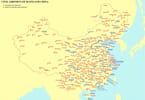Last weekend, the first C130 aircraft arrived from South Africa in the heart of the Serengeti’s Seronera airstrip, greeted by Tanzania President Jakaya Kikwete himself and a large number of officials, volunteers, and TANAPA staff, carrying the precious cargo of 32 Eastern Black Rhinos. The relocation of the species is done, and largely paid for, under the auspices of the government of Tanzania in conjunction with the government of South Africa, and aimed to restore a healthy and widespread rhino population in the Serengeti National Park.
The cost of relocation for each animal is estimated to be in the region of about US$9,000 and is money well spent according to a jubilant source from Arusha who said to this correspondent: “This is a proud day for us. We had our president here to greet the rhinos and speak to us. He reassured the tourism industry that the rhinos will be protected 24/7, and general security of game parks will be improved. I think he knows how important tourism is for our country. Tanzania can make a lot of money from visitors from abroad, and because so many go on safari instead of only the beaches, we are doing financially very well.”
Only weeks ago did a group of other Eastern Black arrive in Tanzania, donated by the Czech Republic. Those animals are now in a secure rhino sanctuary at Mkomazi National Park and are forming the core of a breeding programme there.
The presence of the Tanzanian President underscored the importance Tanzania now attaches to its tourism industry and wildlife conservation, which prior to the recent CITES Conference in Doha had come under sustained criticism over gaps and loopholes, said to aid and abet poaching and facilitating the transit of blood ivory, birds, reptiles and other animals for illegal exportation.
Interesting enough, the ‘rhino returnees’ are offspring of initially 7 sent to South Africa to breed there, when poaching across Eastern Africa was rampant and rhino numbers plummeted across the region, even wiping out the rhinos in Uganda at the time.
A few months ago has the Frankfurt Zoological Society made a massive donation worth nearly 2 million Euros towards capacity building and training of park staff in preparation of the relocation, an effort now paying off as the park service has more vehicles, more communications equipment and more funding for fuel and other recurrent expenses available. The FZS has been supporting the Serengeti since the days of Prof. Dr. Grzimek, whose films and TV narratives ‘Serengeti must not die’ have immortalised the park in Germany and many other parts of the world and helped to continuously raise funds towards conservation efforts in Tanzania.
Meanwhile though it was also learned that another project to popularize the Serengeti across the world through webcam transmissions has stalled due to lack of sufficient funds – it is understood that about one million US Dollars would be required to kick of the project, a figure unlikely to be raised from local sources owing to the general economic situation and the continuing fallout of the global economic and financial crises over the past two years, which is also affecting public finances in Eastern Africa.
WHAT TO TAKE AWAY FROM THIS ARTICLE:
- Meanwhile though it was also learned that another project to popularize the Serengeti across the world through webcam transmissions has stalled due to lack of sufficient funds – it is understood that about one million US Dollars would be required to kick of the project, a figure unlikely to be raised from local sources owing to the general economic situation and the continuing fallout of the global economic and financial crises over the past two years, which is also affecting public finances in Eastern Africa.
- The relocation of the species is done, and largely paid for, under the auspices of the government of Tanzania in conjunction with the government of South Africa, and aimed to restore a healthy and widespread rhino population in the Serengeti National Park.
- The presence of the Tanzanian President underscored the importance Tanzania now attaches to its tourism industry and wildlife conservation, which prior to the recent CITES Conference in Doha had come under sustained criticism over gaps and loopholes, said to aid and abet poaching and facilitating the transit of blood ivory, birds, reptiles and other animals for illegal exportation.






















